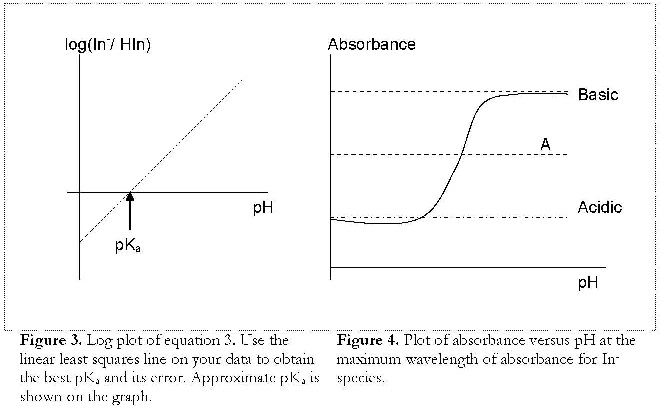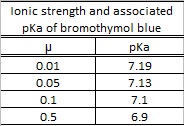Assignment:
SPECTROPHOTOMETRIC DETERMINATION OF THE pKa OF AN ACID-BASE INDICATOR BACKGROUND
Colorful acid-base indicators are organic weak acids or bases that change color at different pH. In this experiment, spectrophotometry is employed to measure the pKa of bromothymol blue, an acid-base indicator. The indicator (HIn) is a monoprotic acid and we can represent its dissociation as follows:
HIn → H+ + In- … (1)
The equilibrium expression for such dissociation can be written as
pH = pKa - log ( [HIn] / [In-] ) … (2)
This can be rearranged to a straight-line equation
log ( [In-] / [HIn] ) = pH - pKa … (3)
Hence, if the log term is plotted vs. pH, the slope is 1, the intercept is -pKa and the line should cross the pH axis at pH = pKa (Figure 3).
The ratio of [In-]/[HIn] can be determined spectrophotometrically. First, a solution of bromothymol blue is prepared in acidic solution where essentially the entire indicator remains in the HIn form. The absorption spectrum is then determined. Second, a solution is prepared in the basic solution where the indicator is in its basic form, In-. The absorption spectrum of In- is then determined. From the two absorption spectra the wavelengths of maximum absorbance of HIn and In- are selected for further measurements.
Buffered solutions with pH values on either side of the pKa of the indicator are then
prepared and the absorbencies measured at selected wavelengths. The solutions contain the same total concentration of indicator, [In-] + [HIn], but the ratios vary with pH. Figure 4 shows a typical plot of absorbance vs. pH at the wavelength of maximum absorbance for the In- species. The terms used in this figure are as follows:
A = absorbance of mixture
Aa = absorbance of the weak acid, HIn
Ab = absorbance of the weak base, In

From the graph it is evident that [In-] / [HIn] = (A - Aa) /(Ab - A). If the wavelength used is the one at which HIn shows a maximum absorbance, the curve will be similar to that shown in Figure 4, except that it will start at high absorbance and curve down to a low absorbance value at high pH.
PROCEDURE
PART I. Preparation of solutions
1. Weigh out precisely 0.02 g of bromothymol blue and dissolve in 200 mL of 20% ethanol.
2. Dissolve 2.4 g of NaH2PO4 (or KH2PO4 ) in water and dilute to 100 mL. The solution is 0.2 M.
3. Dissolve 3.4 g of NaH2PO4 (or KH2PO4 ) in water and dilute to 100 mL. Calculate its molarity.
4. Prepare a small amount of 3 M NaOH. Three grams of NaOH dissolved in 25 mL of solution will provide enough of this reagent.
5. Prepare a series of buffered solutions as follows: Secure seven clean 50 mL volumetric flasks (if it is more convenient to use 100 mL or 25 mL volumetric flasks, the amounts of reagents should be scaled up or down proportionately). Pipet 1.00 mL of the bromothymol blue solution into each flask. Then add the following volumes of phosphate solutions to these flasks. (These volumes can be measured with a 10 mL graduated cylinder.)
|
|
HA
|
A-
|
|
Flask
|
NaH2PO4·H2O
|
Na2HPO4·7H2O
|
|
Number
|
Volume (mL)
|
Volume (mL)
|
|
1
|
5.0
|
0.0
|
|
2
|
5.0
|
1.0
|
|
3
|
10.0
|
5.0
|
|
4
|
5.0
|
10.0
|
|
5
|
1.0
|
5.0
|
|
6
|
1.0
|
10.0
|
|
7
|
0.0
|
5.0
|
The above seven solutions must be made in the proportions listed. If a 100 mL or 25 mL volumetric is used, adjust the volumes proportionally.
To flask 7 add 2 drops of 3 M NaOH solution. Now dilute each solution to the mark and mix thoroughly. Measure and record the pH value of each solution using a pH meter.
It would be wise to make additional solutions that would fit into the log([A-]/[HA]) vs. pH plot. This way if any of your calibrations don’t fit the linear line you can eliminate them and still have plenty of points. Plan on doing this! Do these calculations beforehand. Make at least 5 more solutions in addition to the ones listed above. **
6. Measure the absorbance of solution 1 from 400 to 700 nm using water as a reference, and determine the absorption spectrum of bromothymol blue at low pH (the spectrum of HIn). Plot the absorbance vs. wavelength. This will be done via UV-vis.
7. To determine the absorption spectrum at high pH (the spectrum of In-), measure the absorbance of the solution 7 in the same manner as directed above. Plot the results on the same graph.
8. Using the spectra above, select two wavelengths at which further absorbance measurements will be made. Choose wavelengths at which HIn and In exhibit maximal differences in absorbance.
9. Now measure the absorbencies of each of the seven solutions at the two wavelengths selected.
Prepare a graph of absorbance vs. pH for each of the two wavelengths (like Figure 4). Determine the [In-]/[HIn] in solutions 2 to 6 as explained above and shown in Figure 4. Plot log([In-]/[HIn]) vs. pH (shown by Figure 3) and obtain a value of pKa from the best fit line. Also, calculate the measurement error. Compare your result with the literature value and discuss the effect of ionic strength on the pKa value. Discuss all other sources of errors.
Question 1. Explain why it is not necessary to know the exact concentration of bromothymol blue in the solution.
Question 2. The pKa value can also be determined from Figure 4 - explain.
Question 3. The acid dissociation constant for bromothymol blue is dependent on ionic strength of solution.
Question 4. Determine the ionic strength of bromothymol blue by interpolating the values given below.
